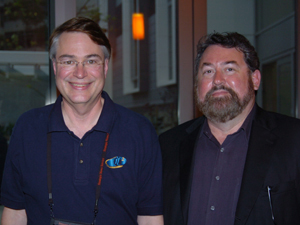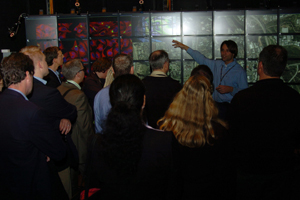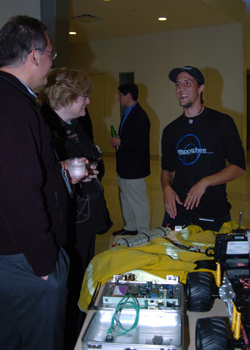Calit2 Provides 'Laboratory of the Future' for Future in Review Conference
San Diego, CA, May 18, 2006 -- The Future in Review is now... past. The annual three-day conference ended Wednesday at the Hotel del Coronado in San Diego, and attendees were treated to a glimpse into the future envisioned by Calit2.
|
Monday's morning session included a conversation with Calit2 director Larry Smarr about using supercomputers and supervisualization techniques. The session was moderated by John K. Thompson, CEO of Marketing Sciences. Smarr got a second bite at the apple, when more than 100 attendees jumped on buses for an outing to the institute's new building at UCSD. There the Calit2 director did a short presentation and demonstrated the 4K super-high-definition visualization system in the institute's auditorium, before letting the visitors loose to tour other labs and demos (Photonics, Virtual Reality, Gaming, Metagenomics) arranged for the event by a number of Calit2's OptIPuter, ResponSphere, CalRadio, and WIISARD projects.
Two of the speakers at this year's FiRe conference will also be back at Calit2 in two weeks to speak at the May 31 U.S.-India Summit on Education, Research & Technology. QUALCOMM chief executive officer Paul E. Jacobs was the kickoff speaker at FiRe, and will co-chair the upcoming Summit being organized by the UCSD Division of Calit2. In Coronado, Jacobs focused on the future of "broadband cellphones" and predicted that the wireless phone - in some form - will take over many of the functions of today's laptops. Also set to speak at the U.S.-India Summit: Sam Pitroda, chairman of India's Knowledge Commission, who talked about India's "advancing position in the value chain."
|
Indeed, India was a major topic of discussion at this year's FiRe. There was a lot of interest in a talk by Azim Premji, CEO of Wipro, one of India's largest computer services firms, who tackled the "future of outsourcing to India." Both Premji and Pitroda made it clear that they see India pushing harder into the high-end of the outsourcing market - doing research and development services at a pace that might have been unthinkable five years ago. A separate panel discussion widened the geographic emphasis to East Asia, asking whether the relationship between Japan and China may hold the "economic key to the next five years."
With a number of top technology journalists participating in FiRE and taking the tour of Calit2, the institute and director Smarr got a fair amount of play in the media and blogosphere. In his blog, Seattle Times tech writer Brier Dudley quoted Smarr as saying that "the technology is now there to make distances disappear, to make it seem the world is wormhole connected" - echoing the Calit2 director's view that rather than the world being flat (per Tom Friedman's bestseller), it's shrinking to a single point where distance is no longer a factor.
For his column in the Seattle Times itself, Dudley reported that FiRe attendees were impressed with the demonstrations and facilities at Calit2. "How do you make a geek drool?," asks Dudley at the beginning of his May 17 article, answering: "Show him or her the stuff being developed at the California Institute for Telecommunications and Information Technology, a collaborative research venture of the University of California campuses at San Diego and Irvine.
|
Apart from the various visualization capabilities and mega-connectivity, reported Dudley, "other gee-whiz demonstrations included a 24-channel digital surround sound system and a prototype of a circa 2015 PC with a 100 million pixel display," referring to the LambdaVision 55-tile, 100-megapixel display system in the Immersive Visualization Lab.
FiRe is organized annually by futurist Mark Anderson, a former writer at Fortune who publishes the Strategic News Service, as a way to develop "an accurate portrait of the future in technology" and how that future will play itself out in a variety of fields.
Other themes getting attention at the 2006 conference: energy, space travel, nanotechnology and biology. The roster of speakers included an eclectic mix ranging from Dell Computer founder Michael Dell and Microsoft co-founder Paul Allen, to two science-fiction writers, including UCSD alumnus David Brin.
Related Links



